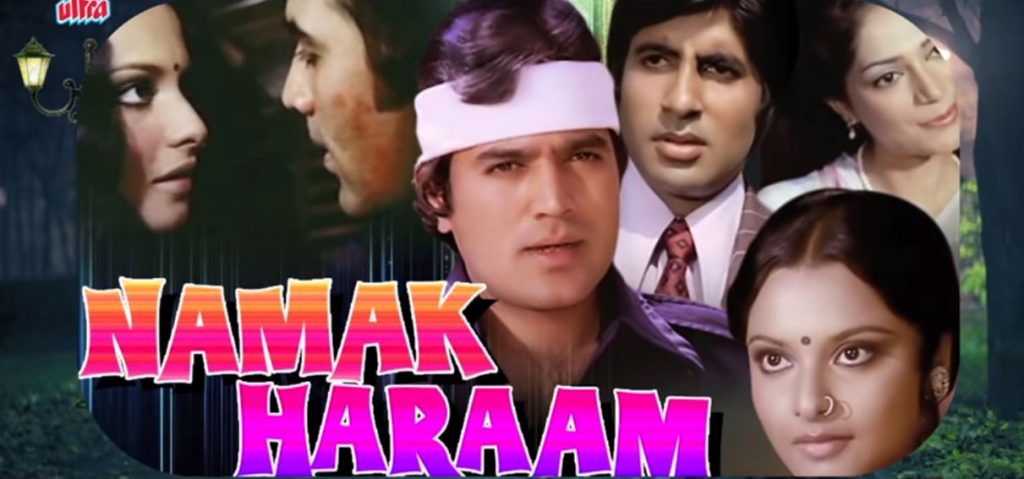Goa is abuzz with excitement as vintage bike and car owners, users, collectors and fans are decking […]

MY DISCOVERY OF CINEMA!
Cover Story, Nov 23- Nov 29 2019 November 22, 2019FAVOURITE: Among my most favourite films has been ‘Namak Haram’ featuring Amitabh Bachchan and Rajesh Khanna. The movie was based on management-labour conflict which I thought was the kind of film which should be financed by the FFC
BY RAJAN NARAYAN
I consider myself to be a veteran of cinema. Way back in the ‘70s I used to write a column on cinema for The Indian Express. I was even selected to be part of the jury for the Filmfare Critics Award where to my disappointment the award went to ‘Dhuvida’. I was present at the first competitive International Film Festival in New Delhi at which the late BR Chopra referred to commercial cinema as randi ka pesha!
Until the late ‘70s my life was one dimensional. It was limited to the print media. It happened that a former classmate had joined the Film & Television Institute of India (FTII) in Pune. He invited me for the weekend for a film-watching holiday. FTII had the best archives set up by PK Nair. Film students and indeed, even ordinary citizens could borrow a film from the archives and watch it, just as you borrow books from circulating libraries. It opened my vision to an entirely new world. I could never imagine that I would be able to sit for almost 12 hours watching the classics from all around the world. From Bergman to Miklos Jansco to Francis Ford Coppola.
The most memorable of the films I saw on that trip was barely ten minutes long. It started showing a man on the gallows about to be hanged. Than the film shows the man escaping, having a picnic playing a football game, skating in the ice, spending precious moments with his family and kids and even cuddling with his grandmother. Than the gallows drop and the prisoner’s dead. All the footage on his escape and his activities during his escape were pure imagination on what was going on in his mind in the few seconds before he was hanged. I can never forget the film which was called “Incident at Owls Creek”.
I then started going to Pune every week. Four of us used to hire a taxi and spend the weekend watching films. That was the time in the late ‘70s when the Film Finance Corporation was formed by the Indian Government. It was intended to provide finance to directors and producers who made distinctive films moving away from the song and dance routine of commercial cinema. This gave rise to producers like Shyam Benegal who first film was interestingly financed by the co-operative of milk producers which was transformed into Amul by Dr Verghese Kurien.
The film ‘Bhumika’ starring the late Smita Patil was an experience in more than a cinematic way. For one thing it was my first flight in a rickety plane to Rajkot where it was being shot. Everything was life size in Rajkot with the cattle being as tall and healthy as men and women. We were all staying in a cottage belonging to the local Raja. There were not many toilets to accommodate all the men. So we had no choice but to practice open defecation which Prime Minister Narendra Modi is trying to ban.
Hearing me talking about cinema and having learnt about my weekly trips to Pune I was made the film critic of The Financial Express, my first paper. My columns were critical of the new wave Indian cinema produced by the Film Finance Corporation. In wanting to provide relief from commercial cinema, the new wave films were all much too artistic for the common man.
On the strength of my column on the new Indian cinema I was invited to be a judge for the Filmfare Critics Award. On the panel there was BK Singh, the deputy editor and Dilip Padgaocar, an assistant editor of the TOI, who had studied in the well known French University (Sorbonne University). The three of us saw an average of six films per day. Of course in luxurious comfort in a private theatre where you could eat and drink as much as you wanted.
The choice finally narrowed down to two films. One of them, made by Mani Kaul, was called ‘Dhuvida’. It was a beautiful film about a ghost. The colours were brilliant. But no common man would understand a word of it.
The other film was made by the late Awtar Krishna Kaul called ‘27 Down’. The film revolved around the suburban trains of Mumbai. It was a metaphor for the monotony of life with the people of the city having catch the 7.32 am train in the morning and the 6.48 pm return train in evening, day after day, year after year, shuttling between residence and office. With rents in the city centre being sky high, people lived 40 or 50 km away and commuted by suburban trains.
I was personally strongly in favour of the award going to ‘27 Down’. Dilip Padgaocar, the French-speaking so-called expert, kept demanding that it should go to ‘Dhuvida’ which means ‘confusion’ in Hindi. Finally, much to my anger. the award went to ‘Dhuvida’. Worse still, Dilip wrote an edit piece calling me a Judas at the feet of Indian cinema. I was so furious that I wrote a paper for the Screen, the film newspaper of the Indian Express group. Coincidentally, the film critic of the London Times, Derrick Malcolm, was so impressed that he reproduced the entire 5,000 word paper in the London Times for which I got a 1,000 pounds — four times the salary I was getting then as a journalist in the Express.
My filmy chakar did not end there. I was invited to Delhi for the first competitive International Film Festival in 1969. It was winter in Delhi in late November and very cold. Since Mumbai winters are not very severe I had not taken any warm clothes with me.
Unlike in Goa the International Film Festival in Delhi was held in over a dozen auditoriums. The opening film was ‘Godfather’ made by Francis Ford Coppola on the gangsters in New York. A seminar was scheduled to be held in Vigyan Bhawan the biggest government auditorium in New Delhi.
At the inauguration of the seminar, the late BR Chopra, the veteran film producer, referred to filmmaking as randi ka pesha (prostitution). There was a huge protest and a small group of filmmakers, including Shyam Benegal, Javed Akhtar and Satyajit Ray walked out, and we all held a parallel seminar on parallel cinema on the lawns of the Vigyan Bhawan.
I continued to see films, particularly the classics at the Film Club that had been started by Basu Chatterjee at Tarabai Hall, an auditorium near Marine Drive in Mumbai. But since coming to Goa there were more opportunities than in the ‘80s to see classic films. The early morning shows in the regular theatres were all porn films. The afternoon shows were the Hindi masala films. There was no Cinephile Club or Sunaparanta to show classic films. And I have yet to learn how to store and download classics on my smart phone when I miss the third dimension and increasingly the fourth dimension in Hindi films. The only 3D film I remember watching is ‘Chota Chetan’ which in Malayalam refers to a mischievous sorcerer.















